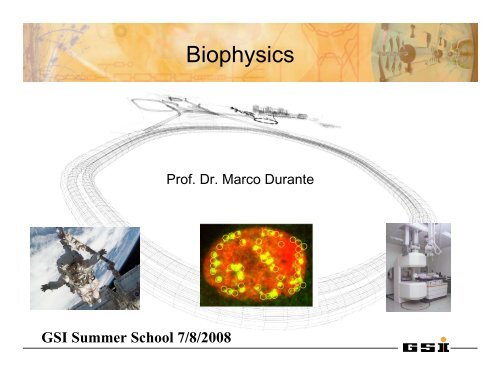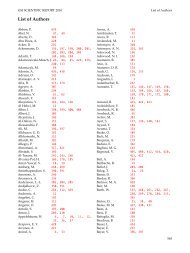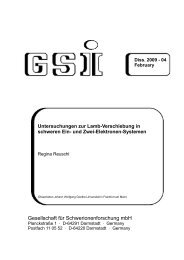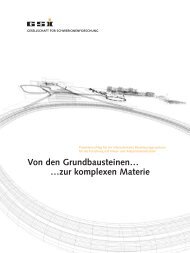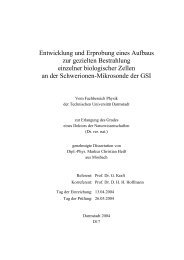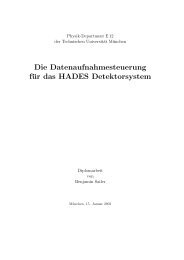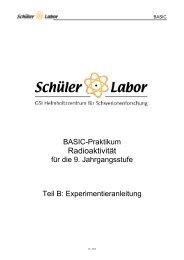Biophysics - GSI
Biophysics - GSI
Biophysics - GSI
Create successful ePaper yourself
Turn your PDF publications into a flip-book with our unique Google optimized e-Paper software.
<strong>GSI</strong> Summer School 7/8/2008<br />
<strong>Biophysics</strong><br />
Prof. Dr. Marco Durante
Table of contents<br />
1. Radioactivity<br />
2. Interaction of radiation with matter<br />
3. Radiobiology<br />
Acute (deterministic) effects<br />
Late (stochastic) effects<br />
Cancer<br />
Noncancer<br />
4. Heavy ions<br />
Space radiation<br />
5. Radiotherapy<br />
Conventional X-ray therapy<br />
Hadrontherapy
November 1895: Roentgen discovers x rays
February 1896: Becquerel discovers radioactivity<br />
1 Bq= 1 disintegration/second
α, β, γ-rays
Interaction of x or γ rays<br />
(photons) with matter: Ionization
Interaction of electrons or ions with<br />
matter:<br />
Ionization (Coulomb interaction)<br />
electron
Radiation Dose<br />
• Radiation effects depends on DOSE= Energy Deposited<br />
by Radiation per Unit Target Mass<br />
• Dose is measured in Gray (Gy) (=1 joule / kg)<br />
• ..but different radiations have different effectiveness (Q)<br />
• Equivalent dose= QxD is measured in Sievert (Sv)<br />
• For X-, γ-rays and electrons: 1 Gy = 1 Sv<br />
• But, for example: 1 mGy α-particles= 20 mSv (Q=20)<br />
• Mammography= 0.01 mSv<br />
• Average background radiation dose on Earth= 3 mSv/year<br />
• Average background radiation dose in space= 1 mSv/day<br />
• Whole-body CT scan=10 mSv<br />
• Occupational limit= 50 mSv/year<br />
• Lethal dose= 4.5 Sv<br />
• Radiotherapy= 60 Gy (to the tumor)
Dose Ranges<br />
(mSievert)<br />
0 10000 20000 30000 40000 50000 60000 70000 80000 90000 100000<br />
0 1000 2000 3000 4000 5000 6000 7000 8000 9000 10000<br />
0 100 200 300 400 500 600 700 800 900 1000<br />
0 10 20 30 40<br />
Typical annual dose for commercial airline flight crews<br />
50 60 70 80 90 100<br />
0 1 2 Natural 3 background 4 5 6 7 8 9 10<br />
NRC Dose Limit for Public<br />
0 0.1 0. 2 0.3 0. 4 0. 5 0.6 0.7 0.8 0. 9 1<br />
EPA Clean-up Standards NRC Clean-up Standards<br />
ICRP Negligible Dose<br />
Typical mission dose on ISS<br />
Thyroid (I-123)<br />
Total Body Therapy Total Tumor Dose<br />
A-bomb survivors<br />
Human LD50<br />
Significant cancer risk at > 200 mSv<br />
(UNSCEAR)<br />
Bone (Tc-99m)<br />
Site Decommissioning/License Termination<br />
Occupational Limit NRC, EPA<br />
0 0.01 0.02 0.03 0.04 0.05 0.0 6 0.0 7 0.08 0.0 9 0.1<br />
3-Mile Island Ave Ind<br />
Cancer Radiotherapy<br />
Experimental Radiobiology<br />
Cancer Epidemiology<br />
Low Dose studies<br />
Dental X-ray<br />
Medical Diagnostics<br />
Chest X-ray<br />
Regulatory Standards
How does radiation injure people?<br />
• High energy radiation breaks chemical<br />
bonds.<br />
• This creates free radicals, like those produced<br />
by other insults as well as by normal cellular<br />
processes in the body.<br />
• The free radicals can change chemicals in the body.<br />
-<br />
+
How does ionizing radiation damage DNA?
How does this damage from ionizing<br />
radiation effect our bodies?<br />
Sufficient Cell Killing<br />
Radiation Sickness<br />
Sufficient Genetic<br />
Alterations<br />
Cancer
RADIATION SICKNESS<br />
System effected/ Syndrome Symptoms Dose<br />
Nervous system<br />
CNS or Cerebrovascular<br />
Syndrome<br />
G.I. system<br />
Gastrointestinal Syndrome<br />
Blood cells / bone marrow<br />
Hematopoietic Syndrome<br />
Skin<br />
Erethema<br />
Ovaries/<br />
Testes<br />
Shock, severe<br />
nausea,<br />
disorientation,<br />
seizures, coma<br />
Nausea, vomiting,<br />
diarrhea,<br />
dehydration<br />
Chills, fatigue,<br />
hemorrhage,<br />
ulceration,<br />
infections, anemia<br />
100 Gy<br />
10 Gy<br />
3-8 Gy<br />
Burning/ infection, 10 Gy<br />
sloughing of skin,<br />
hair loss<br />
Sterility 0.6-0.8 Gy<br />
2-6 Gy
Radiation sickness is possible during radiotherapy, in nuclear<br />
accidents, or from nuclear terrorism<br />
Radioactive<br />
Dispersal Device<br />
(RDD)<br />
Alexander Litvinenko was<br />
poisoned in 2006 with the αradioactive<br />
210 Po<br />
(166 TBq/g and 0.5 µSv/Bq by<br />
ingestion 50 ng are enough<br />
to give a lethal dose of 4.5 Sv!)<br />
Time fuse<br />
Radioactive<br />
material<br />
Detonator<br />
Conventional<br />
explosive<br />
(e.g. fertilizer,<br />
semtex)<br />
Argun, Chechnya, 1999 – A<br />
container filled with<br />
radioactive materials<br />
found attached to an<br />
explosive mine hidden<br />
near a railway line. It<br />
is safely defused.<br />
The location is Argun,<br />
near the Chechen capital<br />
of Grozny, where a<br />
Chechen group, led by<br />
Shamil Basayev, operated<br />
an explosives workshop.
Stochastic late effects
Radiation and Cancer:<br />
A-bomb survivors<br />
87,000 survivors followed<br />
7,800 cancer deaths observed<br />
7,400 expected<br />
Therefore: 400 excess cancers
Extrapolating radiation risks<br />
from high to low doses
Lifetime cancer mortality risk<br />
as a function of age at exposure
Non-Cancer Risks- Acute Gamma Rays<br />
ISS<br />
Mars<br />
Preston et al. Rad. Res. (2003)
Radiation-induced Radiation induced cataracts: Severe<br />
atomic bomb-induced bomb induced cataract<br />
Image from woman who was 21 yrs old at time of the blast, exposed on<br />
the street 805 meters from the hypocenter with acute symptoms.<br />
Photo courtesy of Dr. Tsugihiko Tokunaga
Hereditary Effects<br />
Children of the survivors of the A-bomb attacks have<br />
been studied for:<br />
Untoward pregnancy outcomes<br />
Death of live-born children<br />
Sex chromosome abnormalities<br />
Electrophoretic variants of blood proteins<br />
But no statistically significant effects have been<br />
observed
High-energy<br />
High energy heavy ions<br />
50 um<br />
electrons
(1)<br />
(2)<br />
All radiation tracks are highly structured on the scale of DNA<br />
Heavy ions<br />
electron<br />
DNA<br />
Delta-ray electron<br />
©DTG<br />
21.8.03
An Analogy for Structured Energy Deposition and its Consequences<br />
Low LET radiation produces isotropic damage to organized targets.<br />
High LET radiation produces correlated damage to organized targets.<br />
LET: Linear Energy Transfer<br />
1 Dose Unit<br />
Low LET radiation deposits<br />
energy in a uniform pattern<br />
1 Dose Unit<br />
High LET radiation deposits<br />
energy in a non-uniform pattern
Why are we interested in energetic<br />
heavy ions? ions<br />
Heavy ion radiation is not present naturally on<br />
Earth
The Space Radiation Environment<br />
Solar particle events (SPE) (generally associated with Coronal Mass Ejections<br />
from the Sun):<br />
medium to high energy protons<br />
largest doses occur during maximum solar activity<br />
not currently predictable<br />
MAIN PROBLEM: develop realistic forecasting and warning strategies<br />
Trapped Radiation:<br />
medium energy protons and electrons<br />
effectively mitigated by shielding<br />
mainly relevant to ISS<br />
MAIN PROBLEM: develop accurate dynamic model<br />
Galactic Cosmic Rays (GCR)<br />
high energy protons<br />
highly charged, energetic atomic nuclei (HZE particles)<br />
not effectively shielded (break up into lighter, more penetrating pieces)<br />
abundances and energies quite well known<br />
MAIN PROBLEM: biological effects poorly understood but known to be most<br />
significant space radiation hazard
Trapped radiation belts – measurements<br />
on MIR 18
Relative contribution<br />
1,E+00<br />
1,E-01<br />
1,E-02<br />
1,E-03<br />
1,E-04<br />
1,E-05<br />
1,E-06<br />
1,E-07<br />
Relative contribution of different ions to<br />
flux, flux,<br />
dose, and dose equivalent from<br />
galactic cosmic radiation<br />
Flux Dose Dose equivalent<br />
1 2 3 4 5 6 7 8 9 10 11 12 13 14 15 16 17 18 19 20 21 22 23 24 25 26 27 28<br />
Atomic number (Z)
4-6 crew to lunar surface for extended-duration stay<br />
CEV:Earth-moon cruise – 4 days<br />
Low lunar orbit (LLO) operations- 1 day<br />
Untended lunar orbit operations – 4-14 days<br />
Low lunar orbit operations – 1 day<br />
Moon-Earth cruise – 4 days<br />
Lunar Lander: Lunar<br />
surface operations<br />
60-90 days<br />
2015-2020<br />
2014<br />
4-6 crew to Low Earth Orbit<br />
Crew Exploration Vehicle: Launch Environment<br />
LEO Environment<br />
Earth entry, water (or land) recovery<br />
2025+<br />
2020<br />
Crew TBD to Mars Vicinity<br />
Transit vehicle: Earth-Mars cruise – 6-9 months<br />
Mars vicinity operations – 30-90 days<br />
Mars-Earth cruise – 9-12 months<br />
4-6 crew to lunar surface for<br />
long-duration stay<br />
Lunar Habitat: Lunar surface<br />
operations 60-90 days<br />
Crew TBD to Mars surface<br />
Surface Habitat<br />
2030+<br />
NASA ESMD
Dose (mSv)<br />
10 4<br />
1000<br />
100<br />
10<br />
Radiation doses in different missions<br />
Apollo Skylab<br />
Past Future<br />
STS/Mir<br />
Shuttle<br />
1<br />
Population<br />
per year<br />
Gemini<br />
0.1<br />
1950 1970 1990 2010 2030 2050<br />
Year<br />
ISS<br />
Mars<br />
Moon<br />
Callisto<br />
Astronauts<br />
career<br />
RadWork<br />
per year
ROUGH GUIDES<br />
THE ROUGH GUIDE to<br />
The Moon<br />
& Mars<br />
Health in Deep<br />
Space<br />
1. Protection from space<br />
radiation (particularly very<br />
high energy heavy ions)<br />
2. Psychosocial and<br />
behavioural problems<br />
3. Physiological changes<br />
caused by microgravity<br />
Modified by Mike Lockwood
Biological effects of heavy ions<br />
No human epidemiological<br />
data<br />
γ-rays heavy ions
γ-rays<br />
silicon<br />
iron<br />
Tracks in cells<br />
Cucinotta and Durante, Lancet Oncol. 2006
Dose distribution in micrometer scale<br />
sparsely ionizing photons densely ionizing particles
Chromosomal aberrations induced by heavy ions<br />
3 Gy γ-rays 0.3 Gy Feions<br />
Durante et al., Radiation Research 2002
Cell killing by different radiation types
Definition of RBE
Relative Biological Effectiveness for Cell Inactivation by Ionizing Radiations<br />
© DTG 5.11.03
Tumor Prevalence (%)<br />
100<br />
80<br />
60<br />
40<br />
20<br />
Harderian gland tumors in mice<br />
Iron<br />
Neon<br />
10-3 10-2 10-1 100 101 102 103 0<br />
Fluence, µm 2<br />
Helium<br />
Proton<br />
γ-rays
The good side of radiation: radiation:<br />
radiotherapy
Radiotherapy<br />
Also called “Radiation Therapy”<br />
Part of multi-disciplinary approach to cancer care<br />
Useful for 50-60% of all cancer patients<br />
Can be given for cure or palliation<br />
Mainly used for loco-regional treatment<br />
Benefits and side-effects are usually limited to<br />
the area(s) being treated
Radiotherapy Treatment Goals<br />
maximize the therapeutic radio TR=<br />
probability of tumour control_(TCP)____<br />
probability of normal tissue toxicity (NTCP)<br />
For palliation (e.g. bone metastasis), it is<br />
possible to obtain symptom improvement<br />
without eradicating the tumour
Therapeutic window
Types of radiotherapy<br />
Radiosensitive<br />
Lymphomas<br />
Germ cell tumours<br />
Small cell carcinomas<br />
Radioresistant<br />
Melanoma<br />
Sarcomas<br />
Glioblastomas<br />
External beam (teletherapy)<br />
- Conformal therapy, IMRT (X-rays), hadrontherapy (protons or Cions)<br />
Brachytherapy<br />
– Intracavitary<br />
– Interstitial<br />
– Surface molds<br />
Systemic<br />
– Radioactive Iodine, Strontium, Radio-labeled antibodies
Treatment<br />
planning<br />
Generally, the<br />
total dose to the<br />
tumor is about 60<br />
Gy, given in daily<br />
fractions of 2 Gy<br />
to spare the<br />
normal tissue<br />
X-rays produced<br />
by LINACS (6-15<br />
MV) are normally<br />
used
April 11, 2001<br />
(just prior to 1000cGy/1fr/1day orthovoltage<br />
treatment using 300kvp photons)
Treated area close-up (1 year post radiation)
Side-effects Side effects of Radiotherapy<br />
Acute (1 month)<br />
Pneumonitis/fibrosis of lungs<br />
Hypothyroidism<br />
Xerostomia<br />
Enteritis<br />
Infertility/menopause<br />
Long-term (10-20 years)<br />
Increased risk of secondary cancers<br />
Increased heart disease if chest region treated
Charged particles for therapy
Depth dose distribution of various radiation modalities
Principle of raster scanning
Image of Albert Einstein<br />
produced with the <strong>GSI</strong><br />
rasterscan system using a<br />
430 MeV/u carbon beam of<br />
1,7 mm width (FWHM).<br />
The picture consists of<br />
105x120 pixel filled by<br />
1.5.10 10 particles given in<br />
80 spills (5 sec. each) of the<br />
SOS accelerator. Original<br />
size of the picture: 15 x 18<br />
cm
Slices of a tumor treated at <strong>GSI</strong>
Protontherapy<br />
Choroidal<br />
and iris<br />
melanoma<br />
(60 MeV)<br />
Deep<br />
tumors<br />
(250 MeV)
C-ions ions vs. X-ray ray therapy
Biological<br />
effective dose<br />
W. K. Weyrather, <strong>GSI</strong>
Tissue dependence of RBE
Bestrahlungsraum: Cave M<br />
Röntgenröhre<br />
Bildverstärker<br />
Patientenmaske<br />
Strahlaustrittsfenster<br />
Patientenmonitor<br />
Patient<br />
PET-Kamera<br />
Patiententisch
Adenocystic Carcinoma<br />
O.Jaeckl DKFZ<br />
C12<br />
boost
Adenocystic Carcinoma<br />
combined photons and C12-Boost<br />
C12 Boost<br />
Prior RT 6 weeks after RT
• Clivus Chondrosarcomas<br />
• Patient:23 years old<br />
• Diagnosis: Chondrosarcoma<br />
• Subtotal surgery<br />
• Postoperative radiationtherapy:60Gye<br />
• 3 fields with 20 fraction<br />
vor Bestrahlung<br />
6 Weeks after carbon<br />
tfeatment with a dose of 60 Gye<br />
D.Schulz-Ertner et al.
Adenoidcystic carcinomas:<br />
Photon-IMRT with and without carbon boost<br />
Überleben Tumorkontrolle<br />
survival tumorcontrol<br />
carbon<br />
without carbon<br />
[Schulz-Ertner, Cancer 2005]
Dose –Tumorcontrol curve for Chordomas<br />
Lokale Tumorkontrolle [%] 5J.<br />
Heavy ions, Castro, 1996<br />
Protons, Munzenrider, 1994<br />
Protons, Hug, 1999<br />
<strong>GSI</strong><br />
FSRT, Debus, 2000<br />
Konventionelle RT<br />
mittlere Dosis [Gy]
Future developments<br />
European projects<br />
Darmstadt since 1997<br />
Heidelberg: first RT 2007 ,<br />
Pavia : first RT 2008 ,<br />
Marburg , Wiener Neustadt , Lyon.<br />
Japanese projects<br />
Chiba 1994,<br />
Hyogo 2003 , Gunma
Particle Beam Therapy Facilities in Japan<br />
Cover Area<br />
Gunma Heavy Ion Science Center<br />
C-ion, ion, Micro beam radiotherapy<br />
Gunma Prf.<br />
Niigata Prf.<br />
Nagano Prf.<br />
Tochigi Prf<br />
Saitama Prf.<br />
Wakasa Bay Research<br />
Center(Suruga)<br />
Proton<br />
Hyougo Particle therapy<br />
Center<br />
Proton(2001~)<br />
C-ion(2001~)<br />
Sizuoka Cancer<br />
Center<br />
Proton<br />
Tsukuba University<br />
Proton (1983 〜)<br />
National Cancer<br />
Center Kashiwa<br />
Branch<br />
Proton (1999 〜)<br />
National Institute of<br />
Radiological Sciences<br />
Proton(1979 〜)<br />
C-ion (1996〜)<br />
Working<br />
Construction
Advantages of heavy ion therapy<br />
• Inverse dose profile: higher target dose<br />
lower dose to normal tissue<br />
• Millimeter-precision treatment<br />
• PET beam verification<br />
• High biological effectiveness in the target<br />
• Low biological effectiveness in the entrance channel<br />
• Biological based treatment planning<br />
• Little side effects<br />
• Good tumor control rates 80-90%<br />
Future<br />
• Heavy ion center at Heidelberg<br />
• Many projects over the world<br />
• Treatment of moving organs<br />
• Biologically optimized treatment
Thank you for attention! attention<br />
If you want to learn<br />
more…….<br />
Tuesday, August 12, 3 pm<br />
A primer on heavy ion<br />
physics<br />
Thursday, August 14, 3 pm<br />
A primer on heavy ion<br />
biology


